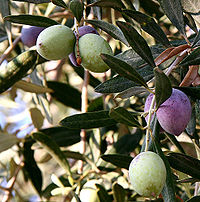
Photo from wikipedia
Olive (Olea europaea L.) is one of the most important tree crops of the Mediterranean regions. In spite of the increasing appreciation of typical extra virgin olive oils at world… Click to show full abstract
Olive (Olea europaea L.) is one of the most important tree crops of the Mediterranean regions. In spite of the increasing appreciation of typical extra virgin olive oils at world level, based on the use of local traditional varieties, very few studies have focused on the genetic characterisation of olive cultivars of regional interest, such as those grown in Veneto, a North-Eastern Italy region. A deep knowledge of the varieties cultivated in this territory is a key step to address the product quality, to increase market demand and to certify the origin of local olive oils. Here we have analyzed olive cultivars and cultivar groups within the olive cultivation area in Veneto, from the Garda Lake to the Euganean and Trevisan hills, by using discriminant SSR markers, in order to obtain a systematic genetic survey of the Veneto regional olive germplasm patrimony. A total of 203 previously uncharacterized olive samples were collected from ancient trees still grown by local farmers. The analyzed samples included also 36 olive reference cultivars from Veneto and neighbour Regions. We found 57 unique molecular profiles out of this set of olive accessions that were split into 15 cultivar groups corresponding to genetically distinct STRUCTURE clusters. Based on a common SSR database, our 239 Venetian accessions were compared with 280 olive reference genotypes representative of the Mediterranean cultivation area. From the genetic structure analysis, it has been observed that 80% of Venetian cultivars clustered in the central Mediterranean group, about 9% and 2% with the eastern and western varieties, respectively, and all the others resulted intermixed among two or three populations. We found that regionally the most common variety was “Casaliva”, corresponding to the widely diffused cultivar “Frantoio”, while others showed identity with known varieties grown in close regions, such as “Leccino”, “Miniol”, “Capolga” and “Bianchera”. Besides these genotypes, others were not matching any known reference and therefore they could be classified as true local varieties of indigenous origin, possibly deriving from the hybridization and selection made by farmers and from their adaptation to the local soil and climate conditions.
Journal Title: Genetic Resources and Crop Evolution
Year Published: 2018
Link to full text (if available)
Share on Social Media: Sign Up to like & get
recommendations!